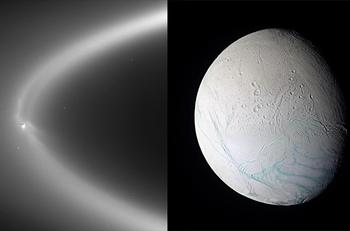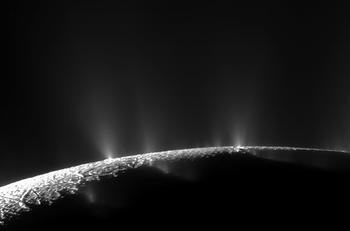Department of Earth Sciences
Service Navigation
Dust in the Saturnian System
Right: Cassini image of the Saturnian E ring with the icy moon Enceladus. Left: Enceladus in false color.
Image Credit: NASA/JPL/Space Science Institute
The Saturn Dust Model will provide an accessible representation of micrometeoroid/dust populations in the Saturnian system. The work is funded by the European Space Agency (ESA, ESA Contract No. 4000143242/23/NL/CRS). A main goal is the quantitative assessment of the hazard imposed by impacts of micrometeoroids on future spacecraft exploring Saturn and its satellites.
Besides the hazard point of view, the Saturnian system with its magnificent rings is an interesting scientific target for cosmic dust research. The icy plumes of the active moon Enceladus feed dust into Saturn’s E ring, interactions between moonlets and the F and G rings release dust into the system, and impacts of interplanetary meteoroids onto Saturn's moons lead to the formation of ejecta clouds in the vicinity of the moons.
Image of the south pole of Enceladus, showing dust emission (water ice grains) from cracks in the ice crust.
Image Credit: NASA/JPL/Space Science Institute
In the project, the dynamical evolution of dust particles in the Saturn system is investigated for a range of grain sizes using numerical integration of the dust trajectories. The motion is followed from the dust sources (moons, rings) to the sinks (impact on moons, rings, Saturn, and escape from the system), taking into account all relevant forces and mechanisms, like gravity, solar radiation, electromagnetic forces, as well as the interaction with magnetospheric plasma, leading to dust charging and erosion.
Ultimately, the model will provide the 3-dimensional distribution of dust in the Saturnian system, preserving the velocity structure and temporal variation throughout the Saturnian year. The model will be informed by data from observations, predominantly results from the Cassini orbiter mission that was exploring the Saturn system from 2004 to 2017.


